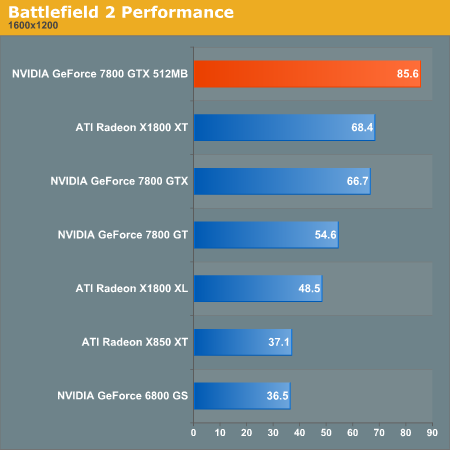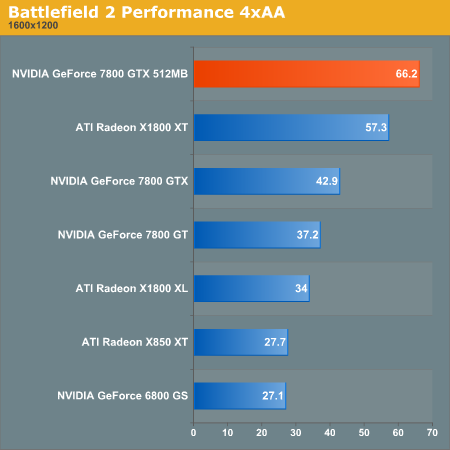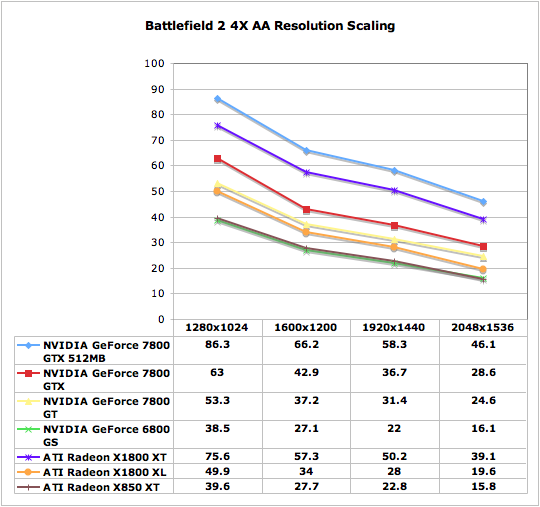NVIDIA GeForce 7800 GTX 512: More Than Just More Memory
by Derek Wilson on November 14, 2005 9:00 AM EST- Posted in
- GPUs
Battlefield 2 Performance
Battlefield 2 is still one of the best (and best looking) of the games to come out over the past six months. Popular with just about everyone who can stand to play a first person shooter, and stressful on hardware at the same time, Battlefield 2 is an important game on our list of tests. We use a custom demo and the DICE supplied demo.cmd (modified to suit our needs) in order to benchmark this game. We also manually compute the average framerate based on the useful frames in timedemo_frametimes file rather than relying on the (flawed) summary output. Unfortunately we seem to have some problems testing SLI using this setup, so we have omitted SLI results for this title.
As we can see in our tests without AA, the 7800 GTX is locked in a dead heat with the X1800 XT, and the 7800 GTX 512 simply dominates both by more than 30%. This is a huge win for NVIDIA's new part given the popularity of this game.


Battlefield 2 is still one of the best (and best looking) of the games to come out over the past six months. Popular with just about everyone who can stand to play a first person shooter, and stressful on hardware at the same time, Battlefield 2 is an important game on our list of tests. We use a custom demo and the DICE supplied demo.cmd (modified to suit our needs) in order to benchmark this game. We also manually compute the average framerate based on the useful frames in timedemo_frametimes file rather than relying on the (flawed) summary output. Unfortunately we seem to have some problems testing SLI using this setup, so we have omitted SLI results for this title.
As we can see in our tests without AA, the 7800 GTX is locked in a dead heat with the X1800 XT, and the 7800 GTX 512 simply dominates both by more than 30%. This is a huge win for NVIDIA's new part given the popularity of this game.














97 Comments
View All Comments
ViRGE - Monday, November 14, 2005 - link
AFAIK 4xAA is the last level of AA that's constant between ATI and NV. The X850 tops out at 6xAA(which NV doesn't have), then there's 8xS, and the list goes on...Griswold - Monday, November 14, 2005 - link
Thats a beast no less. The only thing ATI can do now is kick off that mysterious R580 and it better have a few more pipes than the 520 at the same or even higher clock speeds - and no paperlaunch this time. Or just give up and get the launch right for the next generation...Is there any particular reason for only showing nvidia SLI results and no crossfire numbers at all?
Ryan Smith - Monday, November 14, 2005 - link
This is something we discussed when working on this article, and there's really no purpose in testing a Crossfire setup at this point. The X1800 Crossfire master cards are not available yet to test an X1800 setup, and as we noted in our X850 Crossfire review, an X850 setup isn't really viable(not to mention it tops out at 1600x1200 when we test 2 higher resolutions).Griswold - Monday, November 14, 2005 - link
Ah well, woulda thought AT has a few master cards in their closet. Guess not. :)Kyanzes - Monday, November 14, 2005 - link
ONE WORD: DOMINATIONyacoub - Monday, November 14, 2005 - link
Very interesting to see that 512MB has little to no impact on the performance - it is instead almost entirely the clock speed of the GPU and the RAM that makes the difference.Also, I think this is the first time in PC gaming history where I've seen testing done where video cards more than ~9 months old are all essentially 'obsolete' as far as performance. Even the 7800 GT which only even came out maybe six months ago is already near the bottom of the stack at these 1600x1200 tests, and considering that's what anyone with a 19" or greater LCD wants to ideally play at, that's a bit scary. Then you realize that the 7800GT is around $330 for that bottom-end performance and it just goes up from there. It's really $450-550 for solid performance at that resolution these days. That's disappointing.
ElFenix - Monday, November 14, 2005 - link
no one with a 19" desktop LCD is playing a game at any higher than 1280x1024, in which case this card is basically a waste of money. i have a 20" widescreen lcd and i find myself playing in 1280x1024 a lot because the games often don't expand the field of view, rather they just narrow the screen vertically.tfranzese - Monday, November 14, 2005 - link
SLi/XFire scews the graphes. You need to take that into account when looking at the results.Cygni - Monday, November 14, 2005 - link
We have seen this in every successive generation of video cards. Unless your running AA at high res (ie over 1280x1024), RAM size has little impact on performance. Heck, 64mb is probably enough for the textures in most games.cw42 - Monday, November 14, 2005 - link
You really should have included COD2 in the tests. I remember seeing a test on another site that showed COD2 benefited GREATLY from 512mb vs 256mb of ram.